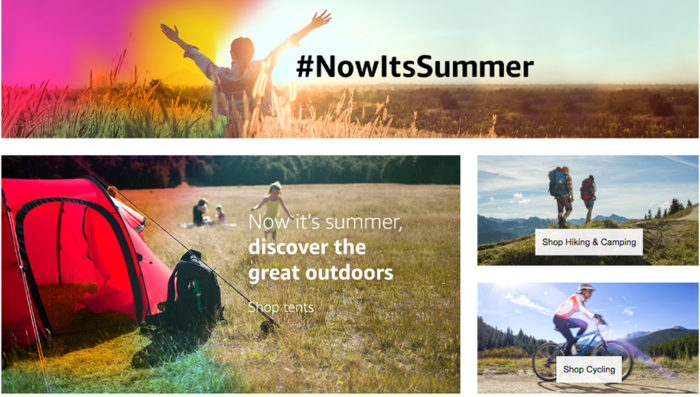You may have seen recently that Amazon launched a weather personalisation tool, able to tailor featured products according to browsers’ local weather conditions – the #NowItsSummer store, based on sales trend data from 2013-2016, which offers everything from products such as sun cream and flip flops to sunglasses, and even stocks umbrellas, anoraks and wellies (for those notoriously unreliable British summers).
I’ll admit: the cynic in me wasn’t much impressed by the news initially; the launch seemed more a clever PR tactic than anything else. But the lesson was unmistakable: personalisation is here to stay. The days of ‘one size fits all’ marketing are over. A shopper’s experience is as important to consider as the product you sell and the prices you offer. If you want to stay competitive now, you need to talk to different types of customers, in different situations, differently – and AI and machine learning is making this happen.
Ditch the stereotype
Self-evident enough, but it bears repeating: your buyers are people first, customers second – apt to tire of you fast if they only hear from you when you want their business. It’s important that they be treated as individuals, not predetermined types or personas; each on their own journey, each deserving of a unique, personalised brand experience, regardless of channel (web, mobile, social).
This is where technologies like marketing automation prove particularly useful – technologies that incorporate AI capabilities in order to better learn and adapt to the behaviours of individual buyers. In principle, AI lets marketers turn the data they’ve gathered on potential customers (demographic and firmographic data, longer-term activity histories and so forth) into better experiences for end users; in practice, Amazon’s new tool for weather personalisation. The applications are endless – communications that aren’t just optimised by buyer and by channel, but even by time of day. Consider this: I have two young children, so I tend to do a lot of my online research between 10 and 11 o’clock at night, including combing through my e-mails. This would be the best time for businesses to reach me, but it could be a terrible time to contact a person who regularly has an early night. By adapting customer journeys with machine learning, marketers can ensure messages go out to recipients at the most optimal time for that specific person.
The customer journey is not simple any more, it cannot be put into boxes and labelled, but AI/machine learning technology can help us predict it and therefore make it unique to the customer.
Where’s the proof?
The numbers tell the same story. Gartner found that by 2020, smart personalisation engines used to recognise customer intent will enable digital businesses to increase their profits by up to 15%. Great for the marketer undoubtedly, but also great for the customer. Customers recognise that personalisation gives them more enjoyable and relevant experiences.
According to a recent report from Accenture, 75% of consumers are more likely to buy from a retailer that recognises them by name, recommends options based on past purchases, or knows their purchase history. Not only that but personalisation can impact how consumers view a brand. Relationships with brands can often be driven by emotions. Feelings derived from a good or bad experience can make their way into a person’s feelings about the brand itself. These days, consumers are feeling frustrated by non-personalised and irrelevant experiences, with 74% of customers feeling frustrated when website content is not personalised according to Infosys.
Rapt Media also found that 63% of consumers said they’d think more positively of a brand if it gave them content that was more valuable, interesting or relevant.
When consumers think more positively about a brand, they are more likely to shop, buy, or even recommend that brand to others. Forrester found that 77% of consumers have chosen, recommended, or paid more for a brand that provides a personalised service or experience.
When you look at the stats, it’s really a no brainer.
Find the right balance
I’m sure we all agree at this point that personalisation is good for both the marketer and the consumer. However, there is a line between a great personalised experience and ‘creepy’ marketing. Not everyone appreciates being reminded how much a company knows about them.
While it has been proven that people tend to like aspects of personalisation that make life more convenient, things like facial recognition to target ads and being greeted by name in stores can be a step too far for some. This also happens when something I thought was a personal and private interaction becomes more publicly exploited; for example, using an email system and then noticing that advertisements related to topics from those ‘private conversations’ appear. Slightly unnerving, to say the least!
One project is even designing clothes that confuse facial recognition software in a bid to protect privacy, as the technology is used more and more for commercial purposes.
The smarter technology gets, the more opportunities there are to target and wow consumers throughout their journey.
According to Econsultancy, it is likely that consumers appreciate less personalisation than most marketers believe. Instead, creating personalised campaigns without using all of the data you have on a customer and not identifying them personally in the material, can avoid the ‘creepy’ label and encourage more engagement with your message.
As a marketing theme, personalisation will undoubtedly continue well into 2017, and innovation technology like AI and machine learning will help create better customer experiences and in turn engagement.
Read also:
Using personalisation and contextual marketing to transform email marketing campaigns

